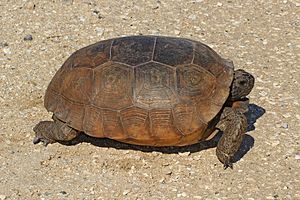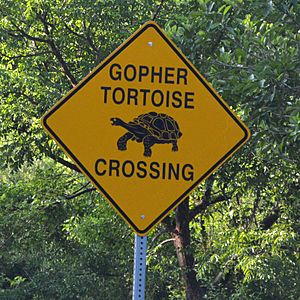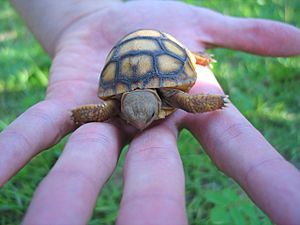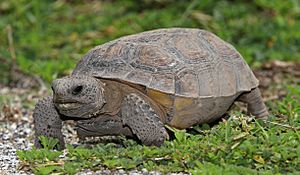Gopher tortoise facts for kids
Quick facts for kids Gopher tortoise |
|
|---|---|
 |
|
| A gopher tortoise in Highlands County, Florida, U.S.. | |
| Conservation status | |
| Scientific classification | |
| Genus: |
Gopherus
|
| Species: |
polyphemus
|
| Synonyms | |
|
|
The gopher tortoise (Gopherus polyphemus) is a type of turtle that lives on land. It belongs to the tortoise family called Testudinidae. These tortoises are found naturally in the southeastern United States.
The gopher tortoise is very important to its environment. It is known as a keystone species. This means it plays a critical role in its ecosystem. It digs burrows that offer homes and safety for at least 360 other animal species. Sadly, the gopher tortoise is currently threatened by predators and the loss of its natural home.
This tortoise is the only type of tortoise found in North America. It is the official state reptile of Georgia and the state tortoise of Florida.
Contents
Naming the Gopher Tortoise
The scientific name for the gopher tortoise is polyphemus. This name comes from Polyphemus, a giant from ancient Greek stories. Polyphemus was known for living in a cave, much like the gopher tortoise lives in its burrows.
What Gopher Tortoises Look Like
The gopher tortoise is a fairly large reptile that lives on land. It has strong front feet that are perfect for digging. Its back feet are thick and elephant-like. These features are common for most tortoises.
The front legs have tough scales. These scales help protect the tortoise while it digs. Gopher tortoises are usually dark brown to gray-black in color. Their bottom shell, called a plastron, is yellow.
You can tell male and female gopher tortoises apart. Males have a curved-in plastron, while females have a flat one. Also, the bony part under a male's head is usually longer than a female's. Adult tortoises are typically 6 to 9.5 inches (15 to 24 cm) long. Some can grow up to 16 inches (41 cm). Their top shell, called a carapace, is at least twice as long as it is tall. On average, they weigh about 9 pounds (4 kg).
Gopher Tortoise Behavior
What Gopher Tortoises Eat
Gopher tortoises are herbivores, meaning they eat plants. They also act as scavengers. Their diet includes over 300 different kinds of plants. They mostly eat broad-leaved grasses, regular grasses, and legumes.
They also enjoy mushrooms and fruits. Some of their favorite fruits include gopher apple, pawpaw, blackberries, and saw palmetto berries. They also eat flowers from various plants. Young tortoises tend to eat more legumes. These plants are higher in protein, which helps them grow.
Gopher tortoises usually get all the water they need from their food. They only drink standing water when there is a very long dry period.
How Gopher Tortoises Dig Burrows
Gopher tortoises are famous for their amazing digging skills. They spend most of their time inside long burrows. These burrows can be up to 47 feet (14.5 meters) long and 10 feet (3 meters) deep.
These burrows are very important. They protect the tortoises from hot summers and cold winters. They also keep them safe from fires and predators. Burrows are especially common in longleaf pine forests. Here, tortoises help the ecosystem by eating plants.
Except during mating season, gopher tortoises usually live alone. They dig several burrows within their living area. Each tortoise needs about 4 acres (16,000 square meters) of land to live comfortably.
Gopher Tortoise Reproduction and Life Cycle
Gopher tortoises have special courtship behaviors before mating. Mating season runs from April to November. Females lay their eggs in the open, usually in a sandy mound near their burrow entrance.
A female can lay between 1 and 25 eggs. The eggs incubate underground for about 100 days. The temperature of the sand determines if the baby tortoise will be male or female. If the sand is warmer than 86 degrees Fahrenheit (30 degrees Celsius), it will be a female. If it's cooler, it will be a male.
Gopher tortoises can live for more than 40 years. One famous tortoise named Gus is very old. As of 2019, Gus was 97 years old. He has lived at the Nova Scotia Museum of Natural History for 75 years.
Tortoises reach maturity when they are about 10 to 15 years old. At this age, their shells are about 9 inches (23 cm) long. They can mate from February through September, with May and June being the busiest months.
Sadly, many eggs do not survive. About 90% of egg clutches are destroyed by predators. These predators include armadillos, raccoons, foxes, skunks, and alligators. Less than 6% of hatched tortoises live to be one year old or older.
Social Behavior Among Tortoises
Some scientists believe that gopher tortoises might be more social than other tortoise species. They live in groups called colonies. These colonies are similar to those of very social animals like prairie dogs.
The way their burrows are spread out might show how tortoises interact. Some female tortoises have been seen visiting the burrows of a specific female many times. They do this even if other tortoises live closer. This behavior could be a type of "friendship" among them.
Protecting the Gopher Tortoise
Since July 7, 1987, the U.S. Fish and Wildlife Service has listed the gopher tortoise as "Threatened." This applies to tortoises found west of the Mobile and Tombigbee Rivers in Alabama, Mississippi, and Louisiana. In Florida and other areas, its status is still being reviewed.
The gopher tortoise is listed as a "Vulnerable" species on the IUCN Red List. This list tracks species at risk worldwide.

Experts have identified five main dangers to the gopher tortoise population:
- Loss of their home due to human development.
- Poor management of their natural areas.
- People wanting them as pets or for food.
- Moving tortoises, which can harm their groups.
- Diseases that spread when tortoises are moved.
Gopher tortoises are known as a keystone species because their burrows help many other animals. The Florida Fish and Wildlife Conservation Commission says that gopher tortoise burrows provide shelter for 350 to 400 other species. These burrows are used for eating, resting, reproducing, and protection from extreme temperatures and predators.
Animals that use gopher tortoise burrows include gopher frogs, several types of snakes like the eastern indigo snake, small invertebrates, and burrowing owls. So, protecting the gopher tortoise also helps these other species.

A lot of gopher tortoise habitat has been lost. This is due to turning their land into cities, farms, and pastures. Also, some forest management practices have harmed their homes. People catching gopher tortoises for food or pets has also hurt some populations.
The loss of adult tortoises is a big problem. It takes a long time for tortoises to grow up and reproduce. They also have a low number of babies. Current estimates show that human hunting and road deaths alone could be stopping the population from growing. In many areas, it's rare to see gopher tortoises, and the ones seen are smaller than before.
Many other animals also prey on gopher tortoises. Raccoons are the main predators of eggs and hatchlings. Other predators include gray foxes, striped skunks, nine-banded armadillos, dogs, and snakes. Red imported fire ants can also attack hatchlings. In 1980, reports showed that nearly 90% of eggs and hatchlings were lost.
In the past, many gopher tortoises were accidentally harmed or killed. This happened when their habitat was developed in Florida. Developers could get permits to build in tortoise areas. However, new rules were put in place on July 31, 2007. These rules require developers to move tortoises to a safe place.
Since April 22, 2009, there have been three types of permits in Florida. Two permits allow tortoises to be moved. They can be moved to another part of the construction site or to a special certified safe area. The third permit allows temporary relocation. This is for when major utility lines are installed. The tortoises are returned to their habitat after the work is done.
In Mississippi, fences have been built along State Route 63. These fences are made of strong wire and are three feet high. They are buried one foot underground to stop tortoises from getting onto the road. The fences have special "turnarounds" that guide tortoises back to safety. Since these fences were built, no gopher tortoises have been reported killed on Route 63.
On July 27, 2016, Florida officials warned people not to paint gopher tortoise shells. Paint can stop them from getting important vitamins from the sun. It can also cause breathing problems and allow harmful chemicals into their bodies. Painting a tortoise shell is also against the law.
Threats from Humans
Humans have eaten gopher tortoises for thousands of years. During the Great Depression, gopher tortoise meat was sometimes called "Hoover Chicken." This was because poor people ate them when they had no work. Some people still see gopher tortoise meat as a special food.
It is now illegal to hunt gopher tortoises or to have their meat or shells. However, illegal hunting still happened as of 2008. This hunting was happening so much that some tortoise groups were disappearing. In 2006, police found tortoise meat in a man's fridge in Florida.
Gopher tortoises have also been kept as pets. When tortoises are kept as pets, they cannot reproduce in their natural homes. Captured gopher tortoises were even used in "tortoise races." This practice was banned in Florida in 1989. Moving a tortoise can harm its environment. This is because the tortoise is often not returned to where it was found. Also, tortoise racing can spread diseases among tortoises. If an infected tortoise is returned to the wild, it can infect other tortoises.
Threats from Climate Change
Climate change is another challenge for the gopher tortoise. It changes their habitat. However, tortoises are slowly adapting through natural selection.
The Florida Fish and Wildlife Conservation Commission says that rising temperatures and changing rainfall patterns can increase invasive species. These new plants might be better at adapting to changes. They could push out the native plants that tortoises need for food. Invasive species can also break up habitats and stress gopher tortoises.
Warmer temperatures might cause sea levels to rise and more storms. Extreme rain or dry periods will mean less land is available. There will also be changes in how much water is available. If sea levels rise by one meter, 20% of protected lands and 30% of natural habitats could be lost. This would happen over several centuries based on current rates. As sea levels rise, storms will move closer to land. This will affect both coastal and ocean environments. Animals may move inland as less land is available. This can spread diseases or disrupt food chains and reproduction.
Threats from Habitat Loss
In 1987, human development in Mississippi, Louisiana, and Alabama caused tortoise populations to drop a lot. The U.S. Fish and Wildlife Service listed them as "endangered" in these areas. Even though populations also dropped in Florida, Georgia, and South Carolina, they were not listed as threatened at that time.
However, habitat loss is still increasing. Southern states continue to grow in human population. More highways are also being built. The southeastern U.S. saw a 20% increase in human population between 1990 and 2000.
One of the best homes for gopher tortoises is the longleaf pine ecosystem. This area has sandy soils that drain well, which is perfect for tortoises. Longleaf pine forests also have many low-growing plants for food. They have open spaces for tortoise eggs to incubate. Since Europeans settled in the area, longleaf pine forests have shrunk by about 96%. This has led to an 80% drop in gopher tortoise numbers. Only about 4% of the original longleaf pine forests remain.
Across the southeast, there are still four large core areas that can protect tortoise habitats. These areas also protect the many different plants and animals of the coastal plain. They are the De Soto National Forest, Eglin Air Force Base, Apalachicola National Forest, and Okefenokee-Oceola. These places offer a chance to bring back forests and lands. They can help animals threatened by habitat loss. Bringing back natural events like fire and flooding would also help restore plant and animal communities.
If Florida's population doubles, gopher tortoises could lose 700 square kilometers (about 270 square miles) of their homes. Due to development, 7 million acres (28,000 square kilometers) of land will be developed. This is the size of Vermont. This will include 3 million acres (12,000 square kilometers) of farmland and 2.7 million acres (11,000 square kilometers) of unused land. This will cause more competition for water between animals and humans. The tortoise's low reproduction rate makes it more likely to decline and even disappear.
Threats from Diseases
Gopher tortoises can get upper respiratory tract diseases (URTDs). These diseases are caused by tiny living things like bacteria and viruses. Symptoms of URTDs include runny noses, watery or gooey eye discharge, and swollen eyelids.
A specific bacterium, Mycoplasma agassizii, can live in tortoises without showing clear symptoms. An antibiotic called enrofloxacin has been used to treat bacterial URTDs.
Long-term studies on desert tortoises show that URTDs can cause populations to decline years after the first infection. However, similar long studies have not been done on gopher tortoises. One study in Florida from 2003 to 2006 found something unexpected. Tortoises that had antibodies for URTD were less likely to die than those without antibodies. However, areas with more tortoises that had antibodies also had more dead tortoises. This might mean that tortoises who survive an infection develop a long-term illness. More studies are needed to fully understand how URTDs affect gopher tortoises.
Protecting Longleaf Pine Forests
The longleaf pine ecosystem is essential for the gopher tortoise to survive. Because of this, efforts are needed to protect this endangered ecosystem. The longleaf pine ecosystem provides special conditions. These include sandy soils that don't have many nutrients. These conditions are perfect for gopher tortoises. Longleaf pines are also very long-lived trees. They can often live for several centuries. Protecting these forests would give gopher tortoises the natural homes they need.
Successful efforts have been made to replant these forests. Environmental groups and private landowners are working together. They want to protect wildlife habitats while also growing crops. These groups help landowners get money to protect wildlife on their land. Most land in the eastern U.S. is privately owned.
Landowners use "prescribed burns" to restore good habitat conditions. Prescribed burns are controlled fires. They are managed by the Safe Harbor Agreement. This agreement helps the U.S. Fish & Wildlife Service. These burns help reduce harmful invasive species. Invasive species like cogongrass and Fire ants threaten tortoises. They can disrupt their homes and kill tortoise eggs. Prescribed fire is a way to create good ground conditions for tortoises and their eggs. It also helps keep many different plants and animals in the area.
Species Gopherus polyphemus at The Reptile Database
See also
 In Spanish: Gopherus polyphemus para niños
In Spanish: Gopherus polyphemus para niños





